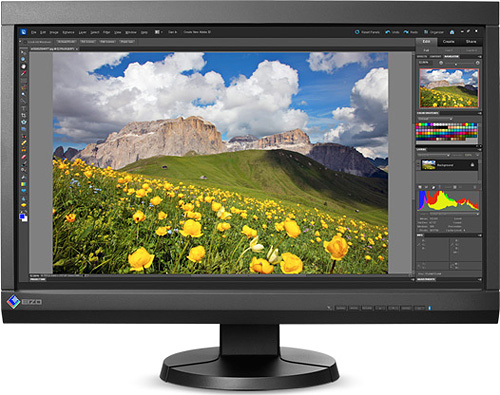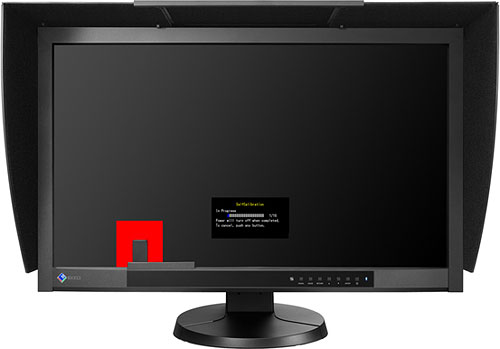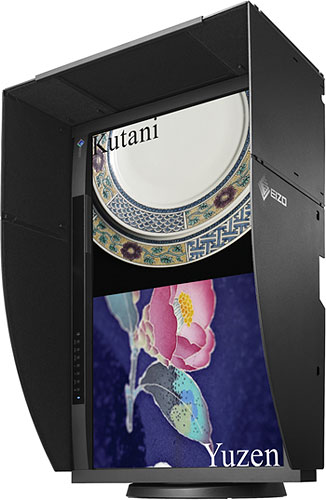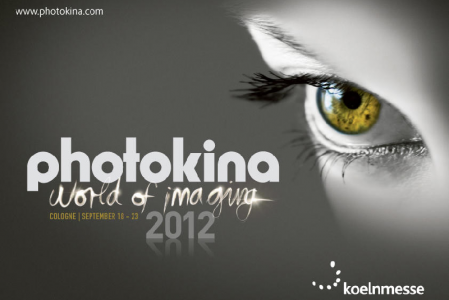From entry-level to pro, Eizo has a self-calibrating monitor for everyone
posted Monday, August 6, 2012 at 1:41 PM EST
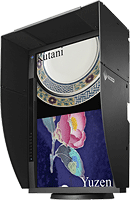 If you're tired of the chore that is monitor color calibration, a raft of new LCD monitors from Japan's Eizo Nanao Corp. will be of interest. Announced last week, the new monitors all make light work of calibration, thanks to an automatic sensor that's hidden in the display bezel, but pops out at intervals to tune the monitor automatically. In all, there are five new models available, spanning the range from the entry-level ColorEdge CS230 up to the pro-oriented ColorEdge CG276.
If you're tired of the chore that is monitor color calibration, a raft of new LCD monitors from Japan's Eizo Nanao Corp. will be of interest. Announced last week, the new monitors all make light work of calibration, thanks to an automatic sensor that's hidden in the display bezel, but pops out at intervals to tune the monitor automatically. In all, there are five new models available, spanning the range from the entry-level ColorEdge CS230 up to the pro-oriented ColorEdge CG276.
It's a design that Eizo introduced a couple of years ago with the ColorEdge CG245W, but now it's made it all the way down to the entry level, albeit with a proviso. Where the SelfCalibration sensor in Eizo's professional displays can completely handle calibration, the more affordable displays among those just announced will still be reliant on an external device for initial calibration. The built-in sensor on these units will be used only to maintain the calibration, and is hence branded as a SelfCorrection sensor. It will still continue to function on a user-defined schedule even when the monitor is completely switched off, though, just as do the SelfCalibration sensors of the more expensive models. That means your calibration stays current with a minimum of fuss.
|
The Eizo ColorEdge CS230 monitor is one of three new displays that can keep its externally-generated calibration current thanks to a built-in, automatically-deployed SelfCorrection sensor that works even when the display is switched off. Photo provided by Eizo. |
Starting at the entry-level point, the Eizo ColorEdge CS230 is based around a 16:9-aspect, 23-inch sRGB IPS panel with a resolution of 1,920 x 1,080 pixels. Dot pitch is about 265 µm, typical brightness and contrast ratio are 300 cd/m2 and 1000:1 respectively, and response time is 10.5 ms gray-to-gray. With a 16-bit lookup table and support for 8-bit or 10-bit display, the Eizo CS230 also includes the company's Digital Uniformity Equalizer technology that aims to reduce variance in brightness and chromaticity across the display surface. It also features the built-in self-correction sensor, and gamma level for each unit is individually calibrated at the factory.
Stepping up the line, the Eizo ColorEdge CX240 has a larger 16:10-aspect, 24.1-inch wide-gamut IPS panel that covers 97% of the Adobe RGB color space, and has a resolution of 1,920 x 1,200 pixels. Dot pitch is about 270 µm, and while typical brightness and contrast ratio are identical to those of the CS230, the gray-to-gray response time is quite a bit faster, at 7.7 ms. The Eizo CX240 has an updated DUE function that also takes account of ambient temperature, and is designed to offer a stable display within seven minutes of power-on. Like the CS230, this model features a SelfCorrection sensor, and so is reliant on an external colorimeter for initial calibration.
|
The Eizo ColorEdge CG246 and CG276 (shown) can calibrate themselves completely automatically thanks to their built-in SelfCalibration sensor. Photo provided by Eizo. |
Next up is the Eizo ColorEdge CX270, which while still offering 97% Adobe RGB coverage, uses a larger, higher-res 27-inch IPS panel with 2,560 x 1,440 pixel resolution. That yields a 233 µm dot pitch, and although typical contrast ratio is identical to its more-affordable siblings, typical brightness is a little higher at 350cd/m2, and response time is even faster at 6 ms gray-to-gray. This model, again, has a SelfCorrection sensor, updated DUE function, 7-minute warm up time, 10-bit display support, and factory gamma calibration.
The Eizo ColorEdge CG246 is the first model in the group that uses a SelfCalibration sensor that can completely calibrate the display, without relying on an external device. It can, however, be correlated to external colorimeters if you need to use a single device to calibrate multiple monitors in a particular work environment. If you don't need to use the same calibration device across multiple monitors, the bundled Eizo ColorNavigator software lets you base your calibration on that of another display for consistent color across multiple devices. Other interesting features include a native 1080/24p mode and deinterlacing function conducive to editing video footage, support for a variety of broadcast color modes, and a safe-area overlay that lets you see whether subtitles and graphics are likely to be cropped on typical displays. The product bundle also includes a landscape / portrait glare shield, an optional extra on the lower-cost models. The Eizo CG246 looks to be based around the same 16:10-aspect, 24.1-inch IPS panel as the ColorEdge CX240.
|
The CG-series models also include a clever portrait / landscape glare shield that's an optional extra on the CX- and CS-series models. Photo provided by Eizo. |
Finally, the flagship of the group is the Eizo ColorEdge CG276. This model looks to be similar in most respects to the ColorEdge CG246, but uses the same 27-inch IPS panel as in the CX270.
Pricing and availability for the new monitors hadn't been disclosed at press time.
Press Release
EIZO Announces New Lineup of ColorEdge Monitors for Graphics Users of All Levels
Hakusan, Japan, July 31, 2012 – Eizo Nanao Corporation (TSE: 6737) today unveiled a new lineup of ColorEdge monitors to appeal to both its traditional core of high-end graphics professionals as well as to middle and entry level users requiring monitors that provide accurate color for their creative endeavors.
The new lineup consists of three series and five models. The three series contain different feature sets, options, and price points for their intended audiences, but retain the hallmarks common to all ColorEdge monitors such as hardware calibration, brightness uniformity, and adjusting the gamma curve of each model on the EIZO factory line before shipping.
The three product series are as follows.
CG Series
The CG series is carried over from the current ColorEdge lineup and will continue to be targeted at professionals in photography, prepress, video editing, post production, and other graphics fields requiring the most advanced monitors available. Common features include easy maintenance with a built-in SelfCalibration sensor, a wide color space, bundled calibration software and shading hood, and several preset modes for common broadcast standards. The new models are the 27-inch ColorEdge CG276 and 24.1-inch ColorEdge CG246.
CX Series
This new series is targeted at Mid-range series for professionals, prosumers and trade schools in photography and design. It comes with a new built-in SelfCorrection sensor that maintains the calibration results after the monitors have been calibrated by an external sensor. It covers most of the Adobe RGB color space. Calibration software and shading hood are available as options. The first models in this series are the ColorEdge CX270 (27") and ColorEdge CX240 (24.1").
CS Series
This series is also new to the ColorEdge lineup and is targeted at entry level users in photography and design. Like the CX series, it comes with a built-in SelfCorrection sensor, but a narrower color space covers most of sRGB. The first CS series model is the ColorEdge CS230 (23").
The built-in SelfCalibration sensor of the CG series is carried over from past ColorEdge monitors. Housed within the front bezel, it swings out and calibrates according to a user-determined schedule. It can calibrate after hours when the computer it is connected to has been turned off.
The built-in SelfCorrection sensor of the CX and CS series is also housed within the cabinet. With the optional EIZO ColorNavigator software, the sensor offers easy maintenance by adjusting the monitor to a calibration result previously obtained by using ColorNavigator and an external sensor.
With the CG and CX series, EIZO has added two technological innovations to improve image stability. The first is a reduction of more than 75% from 30 minutes to just seven minutes in the time it takes for the brightness and chromaticity to stabilize after the monitor is powered on. The other is EIZO’s DUE (digital uniformity equalizer) function which corrects uniformity errors in brightness like in previous ColorEdge monitors, but now also keeps the monitor’s color temperature and brightness stable in an environment with fluctuating ambient temperature changes such as an outdoor photo shoot.
All ColorEdge monitors come with one DVI-I, HDMI, and DisplayPort terminal each for connecting to different types of graphics boards. HDMI offers the additional benefit of direct connection with digital cameras. A USB hub with two upstream and two downstream ports are also included.
Additional Features
-
10-bit display1 (more than 1 billion colors simultaneously) via the DisplayPort input.
-
Ergonomic stand on all models with tilt, swivel, portrait mode, and height adjustment.
-
3D look-up table on all models for better additive color mixture and device emulation on CG series models.
-
I/P (interlace/progressive) conversion on CG and CX series models.
-
Mercury-free LED backlight with CG246, CX240, and CS230.
-
Five-year manufacturer’s limited warranty including the LCD panel for all models and a 12-month pixel defect warranty for the CG series2.
See product pages for more details.
Availability
The new ColorEdge lineup begins shipping in August. Date of availability varies by country so please contact the EIZO subsidiary or distributor in your country for details. EIZO will unveil all new models at Photokina 2012 from September 18 – 23 in Cologne, Germany. The EIZO booth will be in hall 4.1, E31/E39.
About EIZO
Founded in 1968, Eizo Nanao Corporation is a leading global manufacturer of high-end visual display products. The image quality, long-term reliability, and innovative features of EIZO monitors make them the products of choice in many financial trading rooms, back offices, hospitals, air traffic control centers, and design studios throughout the world. EIZO is based in Japan and listed on the first section of the Tokyo Stock Exchange. It is represented in over sixty countries by a network of subsidiaries and exclusive distributors.
For more information, please contact:
Eizo Nanao Corporation
153 Shimokashiwano
Hakusan, Ishikawa 924-8566
Japan
Phone: +81 76 277-6792
Fax: +81 76 277-6793
www.eizo.com
# # #
-
A graphics board and software which support 10-bit output are also necessary for 10-bit display.
-
The usage time is limited to 30,000 hours. RGB full pixel failure is zero for up to 12 months after date of purchase based on ISO9241-307 (pixel failure class I).
